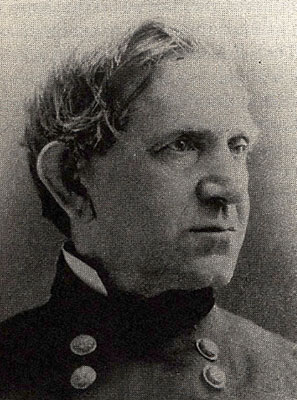|

The heavily erroded ruins of Fort Craig are located about 5 miles
north and 5 miles east of exit 115 on I-25 in New Mexico, about 125
miles north of Las Cruces or 35 miles south of Socorro. The earthen
fortifications built to repulse Sibley's army are still visible. Travel
to the site is on about 5 miles of gravel road.
Fort Craig, New Mexico, one of the largest forts in the West, played
a crucial role in both Indian campaigns and the Civil War. Its primary
function was to control Indian raiding and to protect the central portion
of the Camino Real, a trail which stretched from northern Mexico to
Taos, New Mexico.
Established in 1854, it was constructed on 40 acres leased from the
Armendariz land grant. Named for Captain Louis T. Craig, who had served
in New Mexico and was later killed by deserters in California, the new
post was spacious by frontier standards. Extending 1,050 feet east to
west, and 600 feet north to south, Fort Craig consisted of 22 buildings
of adobe and rock construction around four sides of a large parade ground.
Major structures included the commanding officer's quarters, enlisted
barracks, officer's quarters, warehouses, commissary, ordnance sheds,
stables, hospital and sutler's store. An adobe wall enclosed the post,
and a sally port, or gate, in the west wall provided the only entrance.
Surrounding the fort outside the wall was a defensive ditch, a feature
unique in Southwestern frontier military posts. Fort Craig was designed
for two companies, about 120 men, but it often was garrisoned by four.

General Henry H. Sibley
Picture from the Library of Congress
At the outbreak of the Civil War, Fort Craig remained a Union Army
Post manned by regular army troops. In 1862, troops under the command
of Confederate General Henry Hopkins Sibley continued up the Rio Grande
after capturing military installations to the south. Sibley, previously
stationed at Fort Union, near Las Vegas, New Mexico, resigned his federal
commission to follow his native state of Louisiana into the Confederate
ranks.

Col. Edward Richard Sprigg Canby
Twelve hundred federal troops under Col. Edward R.S. Canby had been
concentrated at Fort Craig to await the Confederates behind new earthern
fortifications bolstered by cannons. When the militia forces, which
included Col. Christopher "Kit" Carson's 1st New Mexico Cavalry,
arrived, Canby had nearly 4,000 men. In fact, the fort was so crowded
that many of the soldiers were forced to pitch tents outside the walls.
Marching north from El Paso, where he had temporarily headquartered,
Sibley led his troops up the Rio Grande Valley in a punishing winter
storm. On the morning of February 21, 1862, Colonel Canby watched as
Sibley's troops marched north on the opposite banks of the river. He
ordered the bulk of his forces out of the post to intercept the Rebels.
Fording the river they attacked and the Battle of Val Verde took place
in the shadow of a long volcanic escarpment of Mesa de la Contadera,
also known as Black Mesa.
Many considered the battle to have been a Confederate victory, but
Union forces succeeded in holding the fort and half of the Confederate's
supply wagons were destroyed. The loss of the remaining supplies at
the Battle of Glorieta, east of Santa Fe, on March 28, 1862 forced the
Confederates on a long and dreary retreat down the Rio Grande Valley
back to Texas and ended southern aspirations for military conquest of
the West. Sibley, who is best known for the invention of the Sibley
tent, later traveled to Egypt where he was made inspector general of
artillery, and devised the plans for the coastal defenses of Egypt and
Alexandria. More

Fort Craig picture from the book, Encyclopedia of Indian Wars, by Gregory F. Michno.
After the Civil War, troops stationed at the fort were able to control
Indian raiding. The surrounding valley prospered under military protection.
The fort was permanently abandoned in 1885. After being under private
ownership, it was eventually donated to the Bureau of Land Management
and is listed on the National Register of Historic Places.
Communities and Related Links
|




